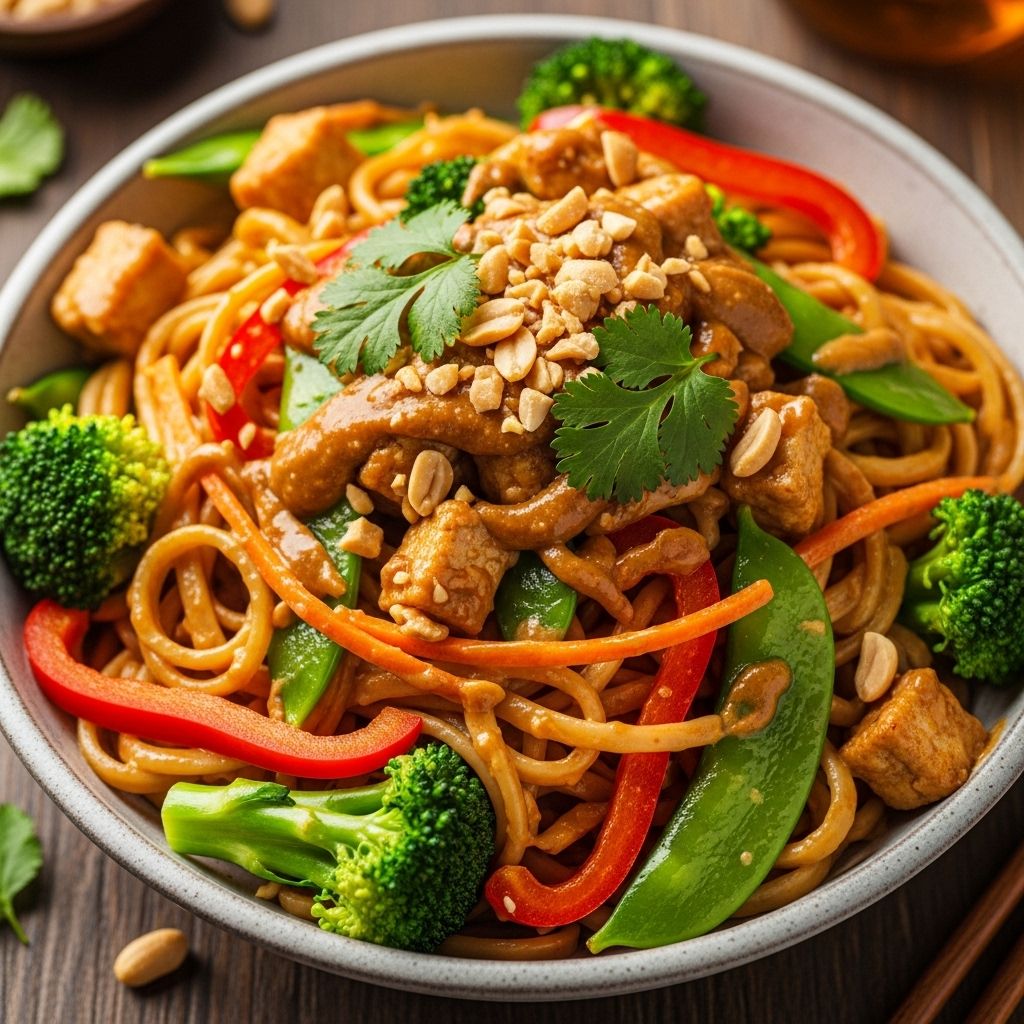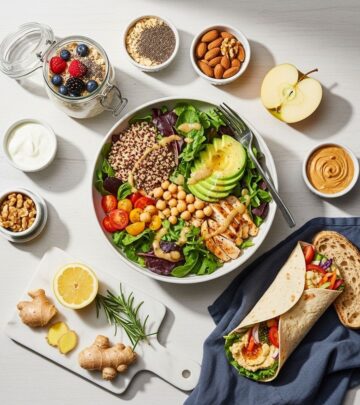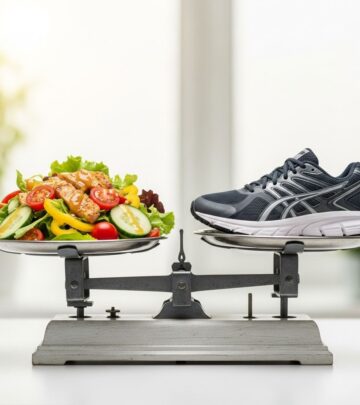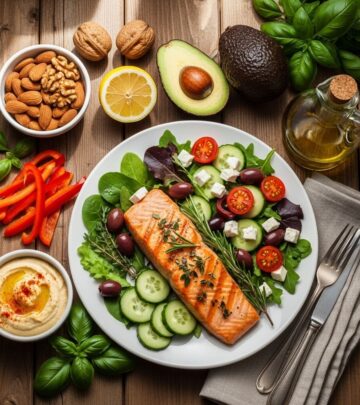Stir-Fry Noodles with Peanut Sauce: Quick & Flavorful
Savor the rich flavors of peanuts, ginger, and chili in this easy stir-fry dish

Stir-fry noodles with peanut sauce represent the perfect marriage of convenience and flavor, bringing together tender protein, crisp vegetables, and a luscious peanut-based sauce that transforms simple ingredients into an extraordinary meal. This Asian-inspired dish delivers restaurant-quality results in your own kitchen, requiring minimal cooking time while maximizing taste and nutritional value. The combination of savory peanut butter, aromatic ginger, and a hint of heat from red pepper flakes creates a sauce that clings beautifully to every strand of noodle, while fresh vegetables add texture and vital nutrients to make this a well-rounded dinner option.
What makes this recipe particularly appealing is its versatility and accessibility. Whether you’re a busy professional looking for a quick weeknight dinner, a parent trying to introduce more vegetables into your family’s diet, or someone exploring Asian cuisine at home, this stir-fry noodles recipe offers something for everyone. The preparation is straightforward enough for beginner cooks, yet the results are impressive enough to serve to guests. With a total time of just 40 minutes from start to finish, including both prep and cooking, this dish proves that homemade meals don’t have to be complicated or time-consuming to be delicious.
Understanding the Foundation of Peanut Sauce Stir-Fry
The essence of this dish lies in its harmonious blend of flavors and textures. At its core, the recipe features ramen-style noodles as the base, which provide the perfect vehicle for the rich peanut sauce. These noodles have a wonderful ability to absorb flavors while maintaining their structure, creating a satisfying bite that holds up well to the robust sauce and vegetables. The preparation method for the noodles is intentionally simple—they’re boiled briefly and then set aside, allowing them to remain firm enough to withstand the final stir-frying process without becoming mushy or overcooked.
The peanut sauce itself is a masterclass in balance. Combining creamy peanut butter with soy sauce creates a foundation that is both rich and savory, while the addition of water helps achieve the ideal consistency that will coat the noodles without being too thick or too thin. This sauce serves multiple purposes in the dish: it acts as a flavor carrier, a binding agent that brings all the ingredients together, and a source of protein and healthy fats that make the meal more satisfying and nutritious. The beauty of this sauce is that it can be prepared while other components are cooking, making efficient use of your time in the kitchen.
Essential Ingredients and Their Roles
Creating exceptional stir-fry noodles with peanut sauce begins with selecting quality ingredients that each contribute something unique to the final dish. The ingredient list is thoughtfully composed to ensure every element serves a purpose, creating a complete meal that satisfies multiple food groups and dietary needs.
Protein Component: The recipe calls for two boneless, skinless chicken breasts, cut into thin strips. This lean protein source cooks quickly and absorbs the flavors of the dish beautifully. When cut into thin strips, the chicken develops a slight caramelization on the outside while remaining tender and juicy inside. The thinness of the strips also ensures even cooking, reducing the risk of undercooked or overcooked meat. The chicken provides essential amino acids and helps make this dish a complete meal that will keep you satisfied for hours.
Vegetable Selection: The vegetable components in this recipe are carefully chosen for their complementary flavors and textures. Two thinly sliced carrots, totaling about two cups, add natural sweetness and a satisfying crunch. Carrots are rich in beta-carotene and provide a vibrant orange color that makes the dish visually appealing. Half a large head of cabbage, thinly sliced to yield approximately six cups, forms the bulk of the vegetable content. Cabbage is an economical choice that provides substantial volume, excellent nutritional value including vitamin C and fiber, and a mild flavor that doesn’t overpower the peanut sauce. The cabbage also has the perfect texture—it softens slightly during cooking but maintains enough structure to provide a pleasant bite. Finally, one-quarter cup of thinly sliced green onions adds a sharp, fresh note that brightens the entire dish and provides a beautiful garnish.
Flavor Builders: The aromatic components are what elevate this dish from good to exceptional. One teaspoon of finely chopped fresh ginger brings a warm, slightly spicy note that pairs perfectly with peanut butter. Fresh ginger is preferable to ground ginger because it provides a more vibrant, clean flavor, though ground ginger can be substituted in a pinch using half the amount. One teaspoon of red pepper flakes introduces heat that can be adjusted according to personal preference—conservative eaters might reduce this to half a teaspoon, while those who enjoy spicier food might increase it slightly. The combination of ginger and red pepper creates a flavor profile that is distinctly Asian-inspired and incredibly aromatic.
Step-by-Step Preparation Process
Success with this recipe depends largely on proper preparation and timing. The cooking process moves quickly once you begin, so having everything ready before you start is crucial. This approach, known as mise en place in professional kitchens, ensures that you’re never scrambling for ingredients while food is cooking on the stove.
Noodle Preparation: Begin by bringing four cups of water to a rolling boil in a medium-sized saucepan, typically two to three quarts in capacity. Once the water reaches a full boil, add the ramen-style noodles to the pot. It’s important to note that you should not add the flavor packets that come with the noodles, as the peanut sauce will provide all the seasoning needed. Immediately after adding the noodles, cover the pot with a lid and remove it from the heat source. This passive cooking method prevents the noodles from becoming too soft or mushy. After exactly one minute, drain the noodles thoroughly in a colander and set them aside. They should be slightly underdone at this point, as they’ll continue cooking when added to the stir-fry later.
Creating the Peanut Sauce: While managing other preparations, make the peanut sauce by combining one-quarter cup of peanut butter, two tablespoons of soy sauce, and half a cup of water in a small saucepan. Place this over low heat and stir continuously until the mixture becomes completely smooth and homogeneous. The heat helps the peanut butter loosen and blend seamlessly with the liquid ingredients, creating a silky sauce. This process typically takes three to five minutes. Once the sauce reaches the desired consistency—pourable but not watery—remove it from heat and set it aside. The sauce will thicken slightly as it cools, which is perfectly normal.
Cooking the Protein: Heat one tablespoon of vegetable oil in a large skillet over medium-high heat. If using an electric skillet, set the temperature to 350 degrees Fahrenheit. Allow the oil to heat until it shimmers slightly, indicating it’s ready for cooking. Add the chicken strips in a single layer, being careful not to overcrowd the pan, which would cause the chicken to steam rather than brown. Cook the chicken for three to five minutes, stirring occasionally, until it’s no longer pink when cut and has developed a light golden color on the exterior. This browning process, known as the Maillard reaction, develops complex flavors that enhance the overall taste of the dish.
Building Layers of Flavor Through Proper Cooking Technique
Once the chicken is cooked through, the vegetable cooking process begins, and this is where timing becomes particularly important. The goal is to cook each vegetable component just enough to soften it slightly while preserving its natural texture and nutritional content. This approach, common in Asian cooking, results in vegetables that are crisp-tender—soft enough to be pleasant to eat but firm enough to provide a satisfying crunch.
Add the red pepper flakes, ginger, and sliced carrots to the skillet with the cooked chicken. Stir everything together to distribute the aromatics evenly, then cook for two to three minutes. During this time, the ginger and red pepper flakes will release their aromatic compounds, infusing the oil and chicken with their distinctive flavors. The carrots will begin to soften around the edges while maintaining their structural integrity in the center. This brief cooking time is sufficient to make the carrots more digestible and sweeter without turning them mushy.
Next, add the sliced cabbage to the pan. You’ll notice the volume is quite substantial—six cups of raw cabbage takes up considerable space in the skillet. However, don’t be concerned; cabbage has a high water content and will wilt down significantly during cooking. Stir the cabbage into the other ingredients, ensuring it makes contact with the heat source, and cook for three to four minutes. The cabbage should reduce in volume by approximately half and become crisp-tender, meaning it offers some resistance when bitten but isn’t raw or tough. The edges of the cabbage may develop slight browning, which adds another layer of flavor complexity to the dish.
Final Assembly and Serving Recommendations
The final steps bring all the components together into a cohesive dish. Add the sliced green onions, drained noodles, and prepared peanut sauce to the skillet with the chicken and vegetables. Using tongs or two spatulas, toss everything together thoroughly, ensuring that the peanut sauce coats every ingredient evenly. This mixing process is important—take your time to lift and fold the ingredients rather than simply stirring, which helps prevent the noodles from breaking apart. The residual heat from the pan will warm the noodles and allow them to absorb some of the sauce, creating a harmonious blend of flavors and textures.
Serve the stir-fry immediately while it’s still hot. The dish is best enjoyed fresh, as the noodles can become slightly sticky and the vegetables may lose some of their crispness if allowed to sit for too long. However, leftovers can certainly be refrigerated and consumed within two hours of cooking, following food safety guidelines. When reheating leftovers, adding a small splash of water and heating gently can help restore some of the original texture.
Nutritional Benefits and Dietary Considerations
This stir-fry noodles recipe offers impressive nutritional value, combining multiple food groups into one satisfying meal. The dish provides a balance of protein from the chicken and peanut butter, complex carbohydrates from the noodles, and an abundance of vegetables that contribute fiber, vitamins, and minerals. The carrots are particularly rich in vitamin A and beta-carotene, supporting eye health and immune function. Cabbage provides vitamin C, vitamin K, and various antioxidants that support overall health. The peanut butter contributes healthy monounsaturated fats, plant-based protein, and various minerals including magnesium and potassium.
For those with dietary restrictions or preferences, this recipe is remarkably adaptable. The dish can be made suitable for various eating patterns with simple modifications. For individuals avoiding peanuts due to allergies, sunflower seed butter serves as an excellent alternative that provides a similar creamy texture and nutty flavor profile without the allergen concerns. Those following a vegetarian or vegan diet can omit the chicken and fish sauce, substituting firm tofu or tempeh for protein and using additional soy sauce or tamari in place of fish sauce. The recipe is naturally dairy-free, making it suitable for those with lactose intolerance or following a plant-based diet.
Customization and Variation Options
While the base recipe is delicious as written, there are numerous ways to customize this dish to suit personal preferences or make use of ingredients you have on hand. The vegetable selection can be varied based on seasonal availability and individual tastes. Bell peppers, snap peas, broccoli florets, mushrooms, or bean sprouts all work wonderfully in this stir-fry. When substituting vegetables, aim to maintain a similar total volume and choose options that have comparable cooking times to ensure everything finishes cooking simultaneously.
The protein component is equally flexible. While chicken breast is specified in the original recipe, chicken thighs offer a more economical option with slightly more flavor and moisture. Pork tenderloin, beef sirloin, or shrimp can replace the chicken entirely, though cooking times may need adjustment. For vegetarian versions, extra-firm tofu, tempeh, or seitan provide excellent protein alternatives. The noodle selection can also be varied—udon noodles, rice noodles, soba noodles, or even whole grain spaghetti can substitute for ramen-style noodles, each bringing its own unique texture and nutritional profile to the dish.
Storage and Meal Prep Strategies
This stir-fry recipe lends itself well to meal preparation strategies, making it an excellent choice for busy individuals who want to enjoy homemade meals throughout the week. The dish can be prepared in larger batches and divided into individual portions for convenient grab-and-go lunches or quick dinners. When storing leftovers, transfer the cooled stir-fry to airtight containers and refrigerate promptly, ideally within two hours of cooking to maintain food safety. Properly stored, the dish will remain fresh and safe to consume for three to four days.
For optimal results when reheating, add a tablespoon or two of water to the container before microwaving, as this helps restore moisture and prevents the noodles from drying out. Alternatively, reheat the stir-fry in a skillet over medium heat, adding a splash of water or additional soy sauce to refresh the dish. Some people prefer to prepare components separately and combine them fresh for each meal—cooking a large batch of peanut sauce and preparing vegetables and protein in advance, then quickly stir-frying individual portions with fresh noodles when ready to eat.
Frequently Asked Questions
Q: Can I make this recipe gluten-free?
A: Yes, this recipe can easily be adapted for gluten-free diets. Replace the ramen noodles with rice noodles or gluten-free pasta, and substitute tamari or coconut aminos for the regular soy sauce. Ensure all other ingredients, including the peanut butter, are certified gluten-free, as some brands may contain trace amounts of gluten from processing facilities.
Q: How can I adjust the spice level in this dish?
A: The heat level is easily customizable by adjusting the amount of red pepper flakes. For a milder version, reduce the pepper flakes to half a teaspoon or omit them entirely. For those who enjoy spicier food, increase to one and a half teaspoons or add a dash of sriracha or chili oil to the finished dish. You can also serve additional hot sauce on the side so each person can adjust their portion to taste.
Q: What type of peanut butter works best for this recipe?
A: Natural peanut butter without added sugars or oils tends to work best, as it provides pure peanut flavor and mixes more smoothly into the sauce. However, conventional peanut butter with added ingredients will also work—just be aware that sweetened varieties may make the sauce slightly sweeter. Avoid chunky peanut butter unless you want texture in your sauce; creamy varieties create the smoothest consistency.
Q: Can I prepare components of this dish in advance?
A: Absolutely. You can slice all vegetables and chicken up to 24 hours in advance and store them in separate airtight containers in the refrigerator. The peanut sauce can also be made ahead and refrigerated for up to five days. When ready to cook, simply bring the sauce to room temperature or warm it gently before adding to the stir-fry. This advance preparation makes the actual cooking process even faster and more efficient.
Q: Why shouldn’t I boil the noodles for the full recommended time?
A: The brief soaking method prevents the noodles from becoming overcooked. Since the noodles will undergo additional heating when combined with the hot vegetables and sauce in the final step, they need to start slightly underdone. Fully cooked noodles would become mushy and might break apart during the final tossing and mixing process.
Q: How can I make this recipe lower in sodium?
A: To reduce sodium content, use low-sodium soy sauce or reduce the amount called for in the recipe. You can also use unsalted peanut butter and season with additional ginger, garlic, or a splash of rice vinegar to maintain flavor complexity without relying heavily on salt. Keep in mind that some sodium helps balance the sweetness of the peanut butter and enhances overall flavor.
Q: What should I serve alongside this stir-fry for a complete meal?
A: This dish is quite complete on its own, containing protein, vegetables, and carbohydrates. However, you could serve it with a light cucumber salad dressed with rice vinegar for additional freshness, or steamed edamame for extra protein. A simple miso soup or clear broth-based soup also makes an excellent accompaniment, particularly during cooler months.
Tips for Perfect Results Every Time
Achieving restaurant-quality results with this stir-fry noodles recipe depends on several key techniques and considerations. First, ensure your skillet or wok is properly heated before adding ingredients. A properly heated cooking surface is essential for developing the slight caramelization on the chicken and vegetables that contributes depth of flavor. When the pan is too cool, ingredients steam rather than sear, resulting in a less flavorful dish.
Another crucial factor is avoiding overcrowding the pan. If your skillet isn’t large enough to accommodate all the ingredients comfortably, consider cooking in batches or using a larger pan. Overcrowded pans trap moisture, preventing proper browning and causing ingredients to steam. This is particularly important when cooking the chicken—if the pieces are too close together, they’ll release moisture and simmer rather than developing that desirable golden-brown exterior.
Pay attention to the texture of your peanut sauce. It should be pourable but not watery, with a consistency similar to heavy cream. If your sauce seems too thick, add water a tablespoon at a time until you reach the desired consistency. Conversely, if it’s too thin, you can add a bit more peanut butter or allow it to simmer slightly longer to reduce and thicken. The sauce should coat the back of a spoon but still flow freely when poured.
Finally, taste and adjust seasonings before serving. Everyone’s palate is different, and factors like the brand of soy sauce or peanut butter used can affect the final flavor. Don’t hesitate to add a splash more soy sauce for saltiness, a squeeze of lime juice for brightness, or additional red pepper flakes for heat. This final seasoning adjustment transforms a good dish into a great one that’s perfectly suited to your preferences.
Read full bio of medha deb












